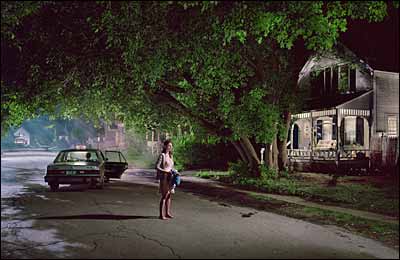
Untitled, Summer 2003 (Maple Street), from Gregory Crewdson’s “Beneath the Roses.” Photograph courtesy of Gregory Crewdson and Luhring Augustine, New York.
Nothing’s more important to the art of the past 50 years than maintaining a knowing detachment, especially when the subject is high-flown feeling. Tragedy? Love? A Beautiful Sunset? Who are you kidding, cornball: You’re just being sold a postcard. Even so, ironists consistently use the grand emotions in their work, often but not always as a foil for a cool, appraising eye. They will sometimes resort to caricature, but that’s usually too easy. A subtler approach—taken repeatedly over the past 50 years—is to make art that simultaneously mocks and awakens sublime feelings. The attitude is, “This is ridiculous, but … ,” which leaves the viewer lost in the ellipsis between irony and passion. That’s what happens, for example, whenever you enter Ed Ruscha’s empty paradise.
This sly approach to the sublime remains very popular. Its early advocates fascinate many people, and young artists with this perspective regularly emerge into public view. At the moment, the sometimes overlooked work of Jack Goldstein (1945–2003)—an artist active in the seventies and eighties—is now being reexamined at Mitchell-Innes & Nash and Metro Pictures. And the art-world tom-toms are currently beating for Gregory Crewdson, a young artist whose show opened at White Cube in London, is now at Luhring Augustine in Chelsea, and will close at the Gagosian Gallery in Beverly Hills. Goldstein first attracted attention in the seventies with a series of deadpan, Warholian film loops that often “appropriate” (the most popular word in the art press) pop clichés. In the best known, MGM, he continuously replayed the visual riff of the roaring Metro-Goldwyn-Mayer lion that introduces movies. The repetition drained the symbol of meaning, mocking the anticipation of an audience eager to be entertained again and again. Yet Goldstein did not just make fun of Leo. In his loop, the trapped monarch has a melancholy poignancy, like an animal from the ancient savannah endlessly retracing his steps in a zoo cage.
In The Jump, Goldstein rotoscoped clips of a diver twisting in the air, turning him into twinkling red and gold light. Here, too, the familiar pop image was transformed into an abstract calculation—but at the same time, the figure has a starry, otherworldly quality. A few years later, in the late seventies and eighties, Goldstein began using similar light effects in paintings. He would appropriate photographs of, among other things, fantastical lightning storms, eclipses, and parachutists hurtling out of planes. The images were then painted in a routine, illustrational style. The effect was to distance the viewer from the sublime by adding two visual filters: first, the photograph itself, and then the affectless painting of the photograph. The viewer assumed the position of the restless lion, separated from a grand, enlarging world.
Crewdson’s show “Beneath the Roses” contains twenty large digital photographs made between 2003 and 2005. Each depicts an emotionally heightened moment or epiphany in which something very important—you never know what—seems to have happened or is about to happen in a small New England town. For example, we see a woman standing, lost in thought, on a suburban street; a taxi is stopped nearby, its door ajar, another passenger still sitting inside. What’s going on? Something shadowy. Like Goldstein, Crewdson filters the dramatic feeling on display; or perhaps the filters are the feeling. Each scene is elaborately staged and produced. Crewdson makes certain the sensation of artifice is inescapable: The images resemble movie stills. Sometimes, he jokes around a bit. One storefront is called “Ad Lib Inc.: Center for Independent Living.”
Crewdson’s photographs have many debts. The campy small-town creepiness owes much to the David Lynch of Blue Velvet or Twin Peaks; Cindy Sherman long ago brought a noirish movie feeling into photographs; even longer ago, O. Winston Link fashioned sets for his hallucinatory pictures of locomotives hurtling through small towns; and Edward Hopper is never far from the image of a lonely woman in an American room, another motif of this photographer. As an artist, Crewdson has not transcended these sources, but, oddly, this sometimes enhances the effect of his pictures. The sources become yet another filter between us and the moments on view, prompting us to ring up art debts even as we watch a woman (who is an actress) contemplating suicide. The MGM lion should introduce the Crewdson show. Life’s a movie. We’re the script.
Films Rrecords Paintings
Jack Goldstein.
Mitchell-Innes & Nash.
Through June 11.
Beneath the Roses
Gregory Crewdson.
Luhring Augustine Gallery.
Through June 18.